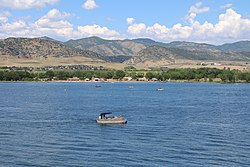| Chatfield State Park | |
|---|---|
 | |
| Location | Douglas / Jefferson counties, Colorado, United States |
| Nearest city | Littleton, Colorado |
| Coordinates | 39°32′12″N105°04′10″W / 39.5366549°N 105.0694299°W [1] |
| Area | 3,895 acres (15.76 km2) |
| Established | 1975 |
| Visitors | 2,159,653(in 2021) [2] |
| Governing body | Colorado Parks and Wildlife |
| cpw | |
Chatfield State Park is a state park located in Douglas and Jefferson counties of Colorado, United States. The park centers on Chatfield Reservoir, a 1,423 acre surface area lake fed by the South Platte River and two other creeks, including Plum Creek. [3]


